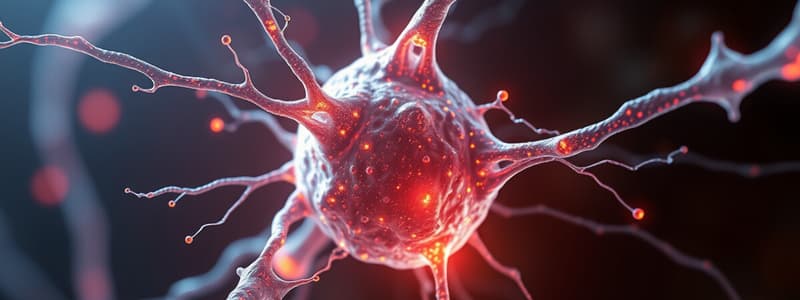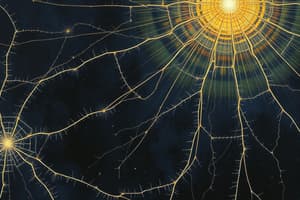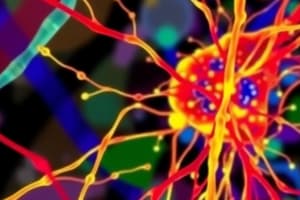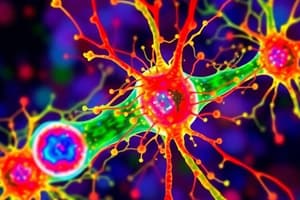Podcast
Questions and Answers
Which component of protoplasm serves as the primary solvent for cellular chemicals?
Which component of protoplasm serves as the primary solvent for cellular chemicals?
- Electrolytes
- Lipids
- Solid particulates
- Water (correct)
What is the primary role of electrolytes in protoplasm?
What is the primary role of electrolytes in protoplasm?
- To provide structure to solid particulates
- To serve as important ions in cellular functions (correct)
- To facilitate chemical reactions in water
- To form cell membranes
Which type of substances are grouped together due to their solubility in fat?
Which type of substances are grouped together due to their solubility in fat?
- Lipids (correct)
- Solid particulates
- Water
- Electrolytes
What is the significance of phospholipids and cholesterol in protoplasm?
What is the significance of phospholipids and cholesterol in protoplasm?
What percentage of total cell mass is made up by lipids?
What percentage of total cell mass is made up by lipids?
What are microtubules primarily responsible for within the cell?
What are microtubules primarily responsible for within the cell?
Which type of proteins are classified as fibrillar proteins?
Which type of proteins are classified as fibrillar proteins?
Functional proteins are characterized by which of the following features?
Functional proteins are characterized by which of the following features?
What are the two major parts of a cell?
What are the two major parts of a cell?
Where are fibrillar proteins predominantly located in the body?
Where are fibrillar proteins predominantly located in the body?
Which statement best describes the role of functional proteins in cells?
Which statement best describes the role of functional proteins in cells?
Which characteristic is NOT typically associated with microtubules?
Which characteristic is NOT typically associated with microtubules?
In which cellular component would you find primarily functional proteins?
In which cellular component would you find primarily functional proteins?
What role does the negative surface charge of many carbohydrate moieties play in cellular interactions?
What role does the negative surface charge of many carbohydrate moieties play in cellular interactions?
Which of the following best describes the glycocalyx?
Which of the following best describes the glycocalyx?
How do some carbohydrate moieties participate in immune reactions?
How do some carbohydrate moieties participate in immune reactions?
What is the function of the carbohydrate moieties acting as receptors on cell surfaces?
What is the function of the carbohydrate moieties acting as receptors on cell surfaces?
What characteristic is true of the endoplasmic reticulum's membrane structure?
What characteristic is true of the endoplasmic reticulum's membrane structure?
Which statement accurately describes the relationship between the endoplasmic reticulum and intracellular processes?
Which statement accurately describes the relationship between the endoplasmic reticulum and intracellular processes?
What is a prominent feature of proteoglycans in relation to the cell surface?
What is a prominent feature of proteoglycans in relation to the cell surface?
In what way are the tubules and vesicles of the endoplasmic reticulum interconnected?
In what way are the tubules and vesicles of the endoplasmic reticulum interconnected?
What is the primary function of the smooth endoplasmic reticulum?
What is the primary function of the smooth endoplasmic reticulum?
What is the process of autophagy primarily concerned with?
What is the process of autophagy primarily concerned with?
Which of the following is NOT a process carried out by the endoplasmic reticulum?
Which of the following is NOT a process carried out by the endoplasmic reticulum?
How do ER vesicles function within the endoplasmic reticulum?
How do ER vesicles function within the endoplasmic reticulum?
Which enzyme process is NOT associated with detoxification by the endoplasmic reticulum?
Which enzyme process is NOT associated with detoxification by the endoplasmic reticulum?
What is the role of lysosomes in relation to the endoplasmic reticulum?
What is the role of lysosomes in relation to the endoplasmic reticulum?
Which component of the endoplasmic reticulum is involved in energy production from glycogen?
Which component of the endoplasmic reticulum is involved in energy production from glycogen?
Which of the following statements about the endoplasmic reticulum is true?
Which of the following statements about the endoplasmic reticulum is true?
What is the primary function of microtubules within a cell?
What is the primary function of microtubules within a cell?
Which statement accurately describes the role of the nucleolus?
Which statement accurately describes the role of the nucleolus?
Which of the following best describes diffusion?
Which of the following best describes diffusion?
What distinguishes active transport from diffusion?
What distinguishes active transport from diffusion?
What is a key characteristic of keratins in epithelial cells?
What is a key characteristic of keratins in epithelial cells?
What role do centrioles play during cell division?
What role do centrioles play during cell division?
Which process is involved in the engulfing of materials by the cell membrane?
Which process is involved in the engulfing of materials by the cell membrane?
What is the role of microtubules in cilia?
What is the role of microtubules in cilia?
Flashcards are hidden until you start studying
Study Notes
The Cell
- Fundamental building blocks of the body, containing hereditary code.
- Comprises two major parts: nucleus and cytoplasm.
Protoplasm
- Composed mainly of five basic substances: water, electrolytes, lipids, carbohydrates, and proteins.
- Water constitutes 70% to 85% of protoplasm, facilitating chemical reactions.
- Electrolytes include vital ions required for cellular functions.
Structure of the Cytoskeleton
- Microtubules: Stiff filaments made of polymerized tubulin, providing rigidity and organization within cells.
- Fibrillar proteins: Found outside the cell, notably in collagen and elastin fibers of connective tissue, vital for structural integrity.
Functional Proteins
- Consist of a few molecules in tubular-globular forms, serving primarily as enzymes.
- Many are mobile, facilitating intracellular chemical reactions and adhering to membranous structures.
Endoplasmic Reticulum (ER)
- Composed of tubular structures (cisternae) that process and transport molecules.
- Smooth ER synthesizes lipids, including phospholipids and cholesterol, with transport vesicles migrating to the Golgi apparatus.
- Plays roles in detoxifying substances, managing drug metabolism through biochemical processes.
Nucleolus
- Contains high concentrations of RNA and proteins, forming components of ribosomes.
- Enlarges during active protein synthesis and participates in cell division.
Cellular Transport Mechanisms
- Diffusion: Movement of substances across membranes, either through pores or lipid matrices.
- Active Transport: Involves physical carrier proteins transporting substances through membranes.
- Endocytosis: Process of cellular intake of substances through membrane invagination.
Autophagy
- Refers to the process of degrading and recycling outdated organelles and protein aggregates, crucial for cellular housekeeping.
Cell Surface Features
- Glycocalyx: A carbohydrate layer covering the cell surface, contributing to negative charge and cell adhesion.
- Carbohydrates attached to the cell surface act as receptors for hormones, facilitating cellular communication and enzyme activation.
Studying That Suits You
Use AI to generate personalized quizzes and flashcards to suit your learning preferences.




